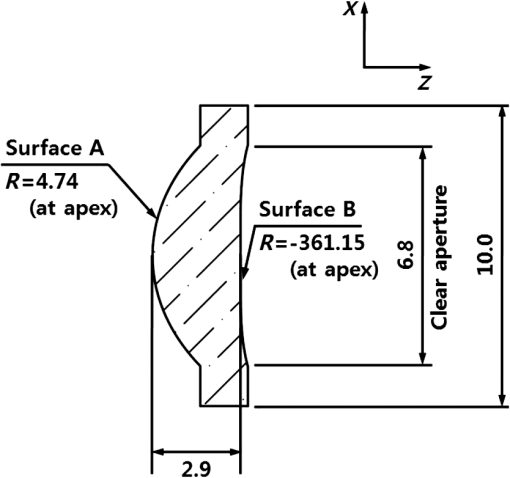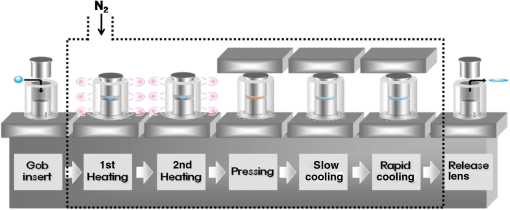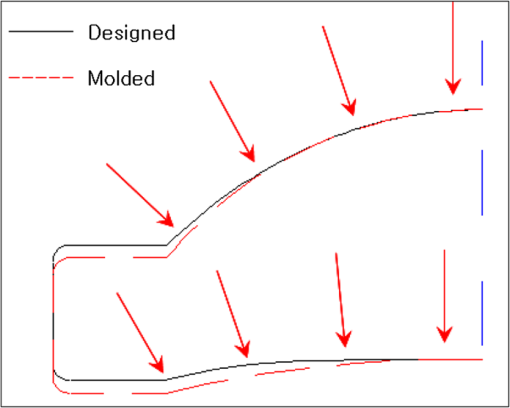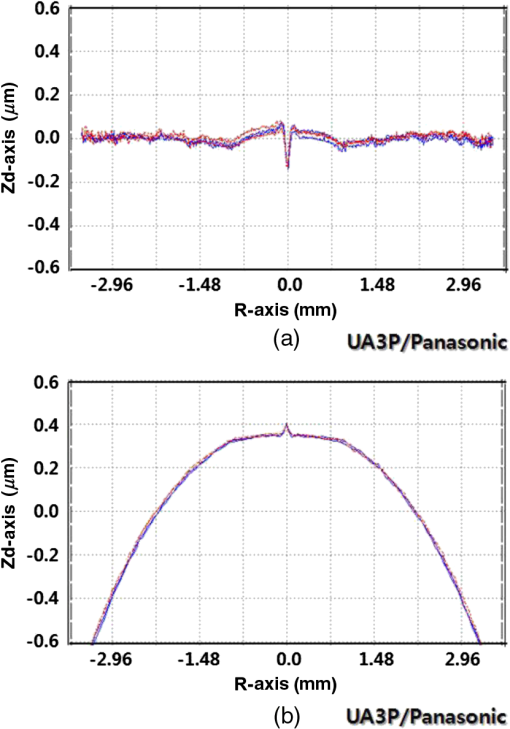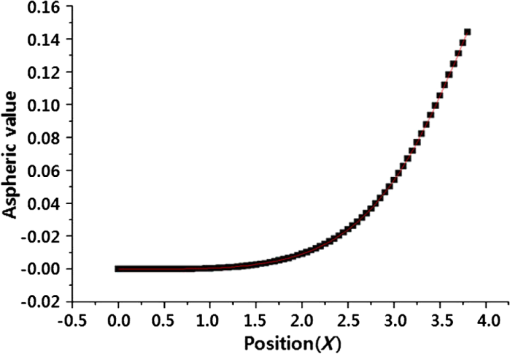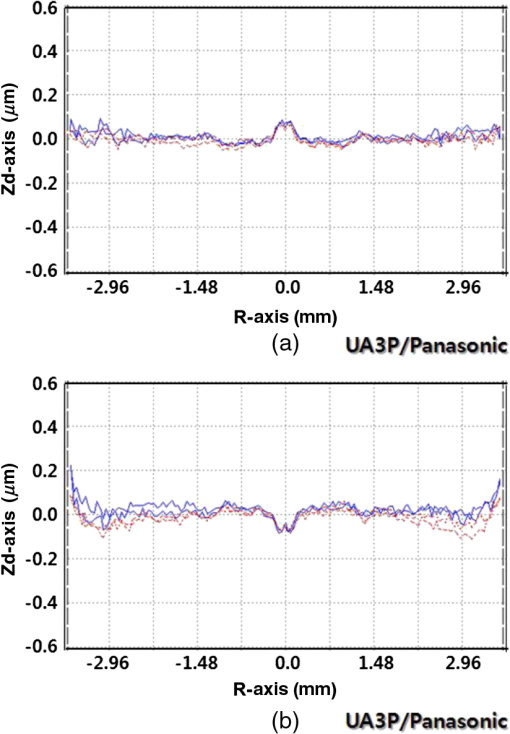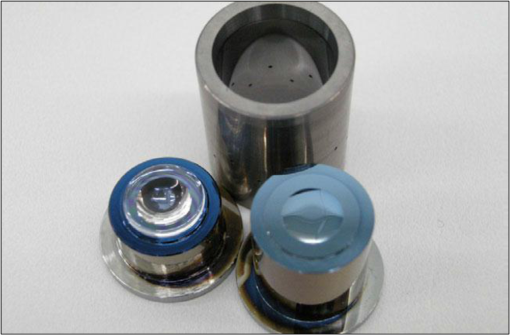|
|
1.IntroductionDue to the tremendous growth in media technology in recent times, the demand for ultraprecision optical components1,2 has increased rapidly. In addition, there has been a corresponding increase in the demand for improvement in optical performance, e.g., higher resolution and brightness. Thus, there is a growing need for precise aspheric glass lenses and ultraprecision grinding of the mold core3,4,5 and molding techniques6 that are able to mass-produce the aspheric glass lenses are needed. Nowadays, the glass molding press (GMP) method6 is favored as the molding technique for aspheric glass lenses because fabrication through conventional glass grinding techniques is not only difficult but also gives a low mass production. Aspheric glass lenses, produced using the GMP method, are molded by treating them by a process in which they are subjected sequentially to heating, pressing, and cooling. This leads to thermal deformation of the lenses, especially in the cooling process. The thermal deformation changes the radii of curvature of the lenses and lowers the performance of the optical system. In this study, the thermal deformation of aspheric glass lenses during the cooling process in the GMP technique was analyzed and the results were applied to the ultraprecision grinding of the mold core in order to improve the performance of lenses used in closed-circuit televisions (CCTVs). 2.Aspheric Glass Lens2.1.Design of an Aspheric Glass LensAspheric surfaces can be represented by a specific equation, Eq. (1), obtained by adding the conic section and the aspheric shape factor where is the inverse of the radius of curvature, is the conic constant, and is the aspheric coefficient. In this case, the surface has a hyperbola, a parabola, an ellipse, and a sphere—various forms of a conic section—rotated about the optic axis, whose form is determined by the conic constant.Figure 1 shows a schematic diagram of an aspheric glass lens for a CCTV optical system. 2.2.Thermal Deformation in the Molding of Aspheric Glass LensesIn general, the GMP process is used for the mass production of aspheric glass lenses. In this study, progressive-type molding was applied to the GMP method. Progressive-type molding is carried out sequentially in the following three stages: heating, pressing, and cooling. This molding technique is suitable for the mass production of uniform aspheric glass lenses. Figure 2 shows a schematic of the progressive-type molding6 used in this study. In the GMP process, glass lenses are molded by heating them above the yield point (at 559°C), followed by pressing and cooling of the glass lenses, after a preform of the glass is loaded in the mold core. During the transition from the pressing stage at high temperature to the cooling stage at room temperature, molded lenses are thermally deformed due to the creation of thermal stress inside the lenses. Thermal stress is caused by the difference in the cooling rate due to the difference in the thickness of a lens. The thermal deformation varies according to the shape and the size of the lenses, leading to errors in the value of the designed lenses’ form accuracy. This further leads to lower optical performance of aspheric glass lenses. Figure 3 schematically describes the thermal deformation during the GMP process. 3.Experimental Equipment and Condition3.1.Experimental EquipmentIn this study, the mold core of an aspheric glass lens was processed using an ultraprecision nonaxisymmetric generator (ASP01, developed by Japan-based Nachi-Fujikoshi Co., Tokyo, Japan). This generator is a tri-axial processing machine equipped with - and -axes tables that are orthogonally driven by two oil hydrostatic pressure slides. An air turbine spindle in the B-axis rotary table, which is driven with an oil hydrostatic pressure bearing, is an ultraprecision machine that is capable of grinding the aspheric surface. Its guide way has a positioning accuracy of 1 nm and is capable of dealing with a structure with a maximum diameter of 150 mm. To mold the aspheric glass lens using a mold core, a progressive type molding machine GMP 54-5s, developed by Japan-based Toshiba Machine Co., (Ooka, Japan) was used. The form accuracy values of the mold core and the molded lenses were measured by an ultrahigh accurate 3D profilometer, UA3P, developed by Japan-based Panasonic Co. (Osaka, Japan) The specifications of the ultrahigh accurate 3D profilometer are listed in Table 1. Table 1Specifications of ultrahigh accurate 3D profilometer (UA3P).
3.2.Experimental ConditionThe mold core of the aspheric glass lens was made by the parallel grinding of tungsten-carbide TJF03 devised by Japan-based Fujidie Co., (Tokyo, Japan) using a diamond-grinding wheel of particle-size #2,000. The specific conditions for grinding the mold core are listed in Table 2. Table 2Grinding condition for mold core.
In the molding of aspheric glass lens ball-type glass L-BAL42, manufactured by Japan-based Ohara Co., (Oyama, Japan) was used, taking into consideration the volume of the designed lens. Table 3 lists the mold conditions of the aspheric glass lens used in this study. To minimize the influence of not only the shrinkage due to the molding of the aspheric glass lenses, but also disturbances caused before and after compensation, the mold core was made as per the grinding conditions listed in Table 2 and 10 aspheric glass lenses were molded as per the molding conditions listed in Table 3. Table 3Molding condition for aspheric glass lens.
4.Molding Analysis and Compensation ProcessThe form accuracy of the mold core made using ultra precision grinding was found to be 0.213 μm peak to vally roughness height (P-V). Ten aspheric glass lenses molded using the grinded mold core were made to have a form accuracy in the range of 3.6 to 3.8 μm (P-V), affected by thermal deformation that occurred during the molding process. It was observed that the values had deviated sharply from the standard specification [below 0.8 μm (P-V)] of the designed lens. Figures 4(a) and 4(b) respectively show the form accuracy of the mold core before the compensation process and an aspheric glass lens after molding. To compensate for the form accuracy errors that occurred during the thermal deformation of the molded lenses, the compensation algorithm, which is given by Eqs. (2) and (3), was used. During the compensation process, the aspheric equation, Eq. (1), was divided into a spherical term and an aspheric term/coefficient to reduce the parameters. The spherical term was made constant to determine the aspheric coefficient using the nonlinear curve-fitting method.7 A sag value of compensation in the aspheric equation was obtained by adding the spherical term of the designed lens and the aspheric coefficient , which is the sum of the aspheric term of the designed aspheric surface and the compensation aspheric term that represents the thermal deformation. In this process, the compensation factor is set at 0.85, and it reduces reshrinkage of the compensated mold core and influences the measurement of errors in lenses. Figure 5 shows the nonlinear curve-fitting results of the shrinkage-compensated aspheric coefficient . The form accuracy of the mold core reprocessed as the compensation shape by ultraprecision grinding was 0.157 μm. The form accuracy of the 10 aspheric glass lenses remolded using the mold core made during the compensation process was found to be in the range 0.3 to 0.45 μm. After the compensation process, the form accuracy of the aspheric glass lenses improved from 3.7 to 0.35 μm. These results agreed with the standard specifications. Thus, it was proven that the compensation algorithm of thermal deformation is suited for molding aspheric glass lenses. Figure 6 shows the form accuracy of a mold core and a molded lens after the compensation process. Figure 7 shows pictures of the mold core and molded lenses. 5.ConclusionIn this study, the thermal deformation phenomenon that occurs during the molding of aspheric glass lenses was analyzed for aspheric glass lenses used in CCTVs. The mold core was reprocessed by using the compensation aspheric coefficient determined by using the nonlinear curve-fitting method for the compensation of thermal deformation during the molding of aspheric glass lenses. The GMP technique was implemented using the reprocessed mold core and the progressive-type molding method, and the following results were obtained:
AcknowledgmentsThis study was performed by supporting of Small and Medium Business Administration Project “A Development of 4cc Laser Projector Engine for Mobile Application” of Small and Medium Business Administration. Thank you. ReferencesL. Michaudet al.,
“New prespectives in monovision—a study comparing aspheric with disposable lens,”
Int. Contact Lens Clinic, 22
(09), 203
–208
(1995). http://dx.doi.org/10.1016/0892-8967(95)00056-Z ICCLEF 0892-8967 Google Scholar
T. Kuriyagawaet al.,
“A new grinding method for aspheric ceramic mirrors,”
J. Mater. Process. Technol., 62
(04), 387
–392
(1996). http://dx.doi.org/10.1016/S0924-0136(96)02440-5 JMPTEF 0924-0136 Google Scholar
H. Suzukiet al.,
“Precision grinding of aspheric CCD-Sic molding die,”
J. Jpn. Soc. Precis. Eng., 32
(01), 25
–30
(1998). Google Scholar
N. AlagumurthiK. PalaniradjaV. Soundaraarjan,
“Optimization of grinding process through design of experiment (DOE),”
Mater. Manuf. Process., 21
(01), 19
–22
(2006). http://dx.doi.org/10.1080/AMP-200060605 MMAPET 1042-6914 Google Scholar
S. S. Kimet al.,
“Ultra-precision grinding optimization of mold core for aspheric glass lenses using DOE and compensation machining,”
J. Korean Soc. Precis. Eng., 24
(06), 45
–50
(2007). Google Scholar
S. H. Changet al.,
“A study on flow characteristics of PBK40 for glass lens forming process simulation using a plate heating type,”
J. Korean Soc. Precis. Eng., 24
(04), 115
–122
(2007). Google Scholar
S. WalshD. Diamond,
“Non-linear curve fitting using Microsoft excel solver,”
Talanta, 42
(04), 561
–572
(1995). http://dx.doi.org/10.1016/0039-9140(95)01446-I TLNTA2 0039-9140 Google Scholar
BiographyDong-kil Lee is a senior researcher at the 3D Convergence Research Center, Korea Photonics Technology Institute. He received his ME degree in mechanical engineering from the Yeungnam University of Mechanical Engineering in 2001. He is currently working toward his PhD degree in mechanical engineering from the Chonnam National University of Mechanical Engineering. He is the author of 28 journal papers. His research interests include optical components, optical applications, and precision mechanical engineering. He is a member of KSPE. Jun-girl Oh is a researcher at the 3D Convergence Research Center, Korea Photonics Technology Institute. He received his BE degree in mechanical engineering from the Chonbuk National University of Mechanical Engineering, Jeonju, Republic of Korea in 2011. He is currently working toward his ME degree in mechanical engineering from the Chonnam National University of Mechanical Engineering, Gwangju, Republic of Korea. His current research interests include optical components, optical applications, and precision mechanical engineering. Won-Gun Jang is a senior researcher at the 3D Convergence Research Center of Korea Photonics Technology Institute. He received his PhD degree at the University of Colorado, Boulder, USA in 1998 in the field of soft-condensed matter physics. He was a postdoc at Liquid Crystal Institute of Kent State University in 1999. He is currently a senior researcher at KOPTI since 2001. His interests include organic displays, optical lens design, and optical components of concentrated photovoltaics. Yang-gyu Kim is a senior researcher at the 3D Convergence Research Center, Korea Photonics Technology Institute. He received his master’s degree in technology management from the Chonnam National University, Republic of Korea in 2011. His current research interests include 3D display applications and optical application engineering. Kwanghoon Lee is senior research scientist at the 3D Convergence Research Center (3D-CRC) of Korea Photonics Technology Institute (KOPTI), where he is responsible for R&D field in three-dimensional (3D) displays such super/multiview auto-stereoscopic 3D display, projection type of 3D display and pseudo and classical/digital holographic 3D display. Specially, he is one of the experts to 3D display system design and 3D optical property analysis based on human engineering. Anjin Park received his MS and PhD degrees in computer engineering from Soongsil University in 2006 and 2009, respectively. He was at National Institute of Advanced Industrial Science and Technology, Japan, and Korea Institute of Science and Technology, Korea, as a postdoctoral research and is currently a senior research scientist at Korea Photonics Technology Institute in Gwangju, Republic of Korea. His research interests include 3D modeling, computer vision in 3D, and computer graphics. |

